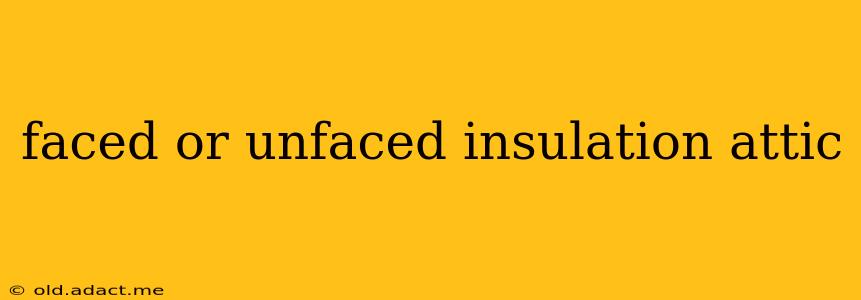Choosing the right insulation for your attic is crucial for energy efficiency and home comfort. Two popular options are faced and unfaced insulation, each with its own advantages and disadvantages. Understanding the differences will help you make the best choice for your needs.
What is Faced Insulation?
Faced insulation is fiberglass insulation with a protective facing, typically a paper or foil-faced material. This facing provides a vapor barrier, helping to prevent moisture from entering the insulation and potentially causing damage or mold growth. It's often easier to install and provides a cleaner look, as the facing acts as a finished surface.
What is Unfaced Insulation?
Unfaced insulation, also known as "blankets," is fiberglass insulation without a facing. It's typically more affordable than faced insulation. However, because it lacks a vapor barrier, careful consideration must be given to your attic's ventilation to prevent moisture problems.
Which Type of Insulation is Better for My Attic?
The "better" type depends entirely on your specific attic conditions and climate. There's no one-size-fits-all answer. Let's explore some key factors:
H2: Does faced insulation prevent moisture?
Faced insulation helps prevent moisture from entering the insulation itself. The vapor barrier provided by the facing material slows down the movement of moisture. However, it's not a foolproof solution. Proper attic ventilation remains critical, regardless of whether you use faced or unfaced insulation. Excessive moisture can still accumulate if ventilation is inadequate, potentially leading to mold growth even with a vapor barrier.
H2: Can I use unfaced insulation in my attic?
Yes, you can use unfaced insulation in your attic, but it requires careful planning and execution. Because it lacks a vapor barrier, you must ensure your attic has adequate ventilation to prevent moisture buildup. This typically involves proper soffit and ridge vents to allow air circulation. Poor ventilation with unfaced insulation can lead to significant moisture problems and potential damage to your home.
H2: Is faced insulation more expensive than unfaced insulation?
Generally, yes, faced insulation is slightly more expensive than unfaced insulation. The added cost is due to the facing material and the extra manufacturing process. However, this price difference is often minimal compared to the overall cost of insulating your attic.
H2: What are the pros and cons of each type?
Faced Insulation:
Pros:
- Built-in vapor barrier
- Easier installation for DIYers
- Cleaner, more finished look
Cons:
- Slightly more expensive
- Can be less flexible in fitting irregular spaces
Unfaced Insulation:
Pros:
- More affordable
- More flexible and easier to conform to irregular spaces
Cons:
- Requires careful attention to attic ventilation
- Installation can be messier
- No built-in vapor barrier
H2: How do I choose between faced and unfaced insulation?
Consider these factors:
- Your climate: In humid climates, faced insulation is generally preferred due to its vapor barrier. In drier climates, unfaced insulation may be a suitable option if you have excellent attic ventilation.
- Your DIY skills: Faced insulation is often easier for beginners to install.
- Your budget: Unfaced insulation is the more affordable choice.
- Your attic's ventilation: Adequate attic ventilation is crucial, especially with unfaced insulation. Poor ventilation can lead to serious problems regardless of the type of insulation used.
Ultimately, consulting with a qualified insulation professional is recommended. They can assess your attic's specific needs and recommend the best type of insulation for your home, considering your climate, budget, and existing attic conditions. This ensures optimal energy efficiency and prevents potential problems down the line.
